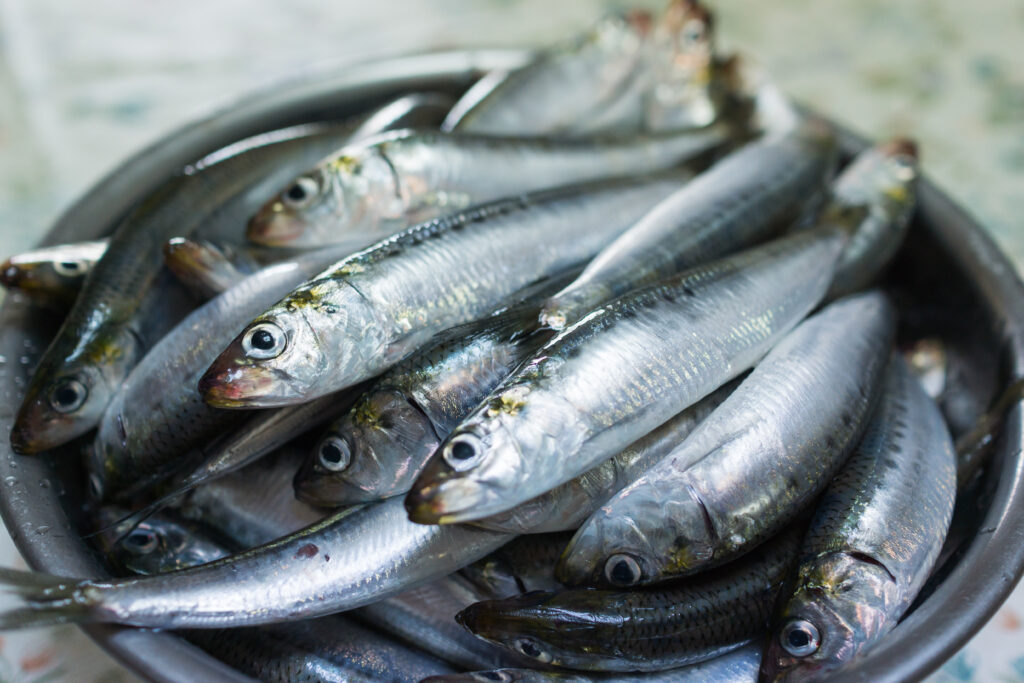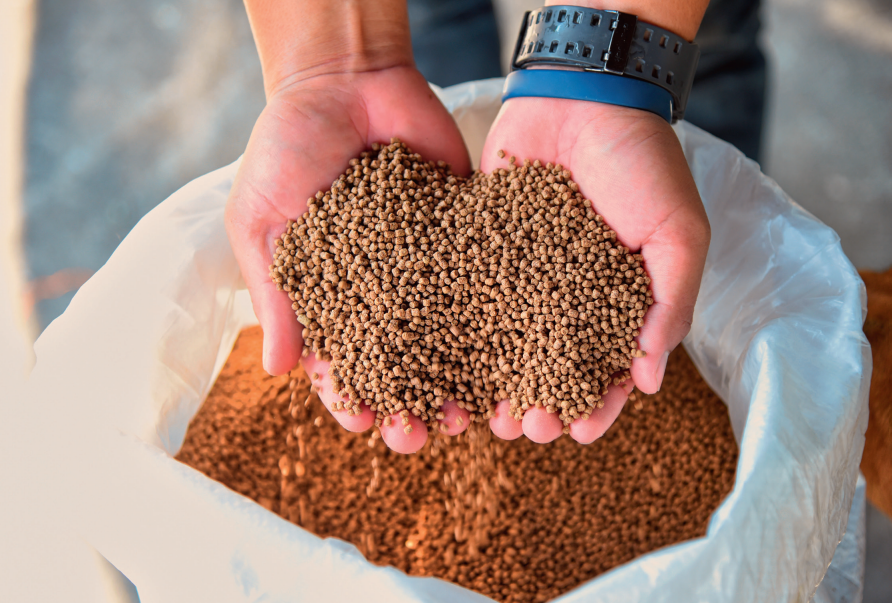More wild fish should be eaten, not fed to salmon, scientists say

Consumers would get a better mix of nutrients if they ate more of the wild fish species that are typically used for salmon feed.
That’s the message from a study by scientists from four leading UK universities, who analysed the nutrient content of wild caught fish such as mackerel, anchovies and herring and compared it to the nutrients in a typical farmed salmon fillet.
Oily fish contain essential nutrients including calcium, B12 and omega-3 but some of these are lost from our diets when we just eat salmon, the researchers say. They found that farmed salmon production leads to an overall loss of essential dietary nutrients, and argue that eating more wild “feed” species directly could benefit our health while reducing aquaculture’s demand for finite marine resources.
The researchers analysed the flow of nutrients from the edible species of wild fish used as feed, to the farmed salmon they were fed to. They found a decrease in six out of nine nutrients in the salmon fillet – calcium, iodine, iron, omega-3, vitamin B12 and vitamin A, but increased levels of selenium and zinc.
Most wild “feed” fish met dietary nutrient recommendations at smaller portion sizes than farmed Atlantic salmon, including omega-3 fatty acids which are known to reduce the risk of cardiovascular disease and stroke.
“What we’re seeing is that most species of wild fish used as feed have a similar or greater density and range of micronutrients than farmed salmon fillets,” said lead author, Dr David Willer, Zoology Department, University of Cambridge.
“Whilst still enjoying eating salmon and supporting sustainable growth in the sector, people should consider eating a greater and wider variety of wild fish species like sardines, mackerel and anchovies, to get more essential nutrients straight to their plate.”

Aquafeed – is this the best use for an anchovy?
In the UK, 71% of adults have insufficient vitamin D in winter, and teenage girls and women often have deficiencies of iodine, selenium and iron. Yet while, 24% of adults ate salmon weekly, only 5.4% ate mackerel, 1% anchovies and just 0.4% herring.
“Making a few small changes to our diet around the type of fish that we eat can go a long way to changing some of these deficiencies and increasing the health of both our population and planet,” said Willer.
The researchers concluded that consuming one-third of current food-grade wild feed fish directly would be the most efficient way of maximising nutrients from the sea.
“Marine fisheries are important local and global food systems, but large catches are being diverted towards farm feeds. Prioritising nutritious seafood for people can help improve both diets and ocean sustainability,” said senior author Dr James Robinson, Lancaster University.
This approach could help address global nutrient deficiencies, say the team of scientists from the University of Cambridge, Lancaster University, University of Stirling and the University of Aberdeen.
The study was published today in the journal, Nature Food.
The scientists calculated the balance of nutrients in edible portions of whole wild fish, used within pelleted salmon feed in Norway, compared to the farmed salmon fillets.
They focused on nine nutrients that are essential in human diets and concentrated in seafood – iodine, calcium, iron, vitamin B12, vitamin A, omega-3 (EPA + DHA), vitamin D, zinc and selenium.
The wild fish studied included Pacific and Peruvian anchoveta, and Atlantic herring, mackerel, sprat and blue whiting – which are all marketed and consumed as seafood.
They found that these six feed species contained a greater, or similar, concentration of nutrients as the farmed salmon fillets. Quantities of calcium were over five times higher in wild feed fish fillets than salmon fillets, iodine was four times higher, and iron, omega-3, vitamin B12, and vitamin A were over 1.5 times higher.
Wild feed species and salmon had comparable quantities of vitamin D.
Zinc and selenium were found to be higher in salmon than the wild feed species – the researchers say these extra quantities are due to other salmon feed ingredients and are a real mark of progress in the salmon sector.

Dr David Willer, Zoology Department, University of Cambridge
Eat or feed?
“Farmed salmon is an excellent source of nutrition, and is one of the best converters of feed of any farmed animal, but for the industry to grow it needs to become better at retaining key nutrients that it is fed. This can be done through more strategic use of feed ingredients, including from fishery by-products and sustainably-sourced, industrial-grade fish such as sand eels”, said Dr Richard Newton of the Institute of Aquaculture, University of Stirling, whose team also included Professor Dave Little, Dr Wesley Malcorps and Björn Kok.
He added: “It was interesting to see that we’re effectively wasting around 80% of the calcium and iodine from the feed fish – especially when we consider that women and teenage girls are often not getting enough of these nutrients”.
Willer said: “These numbers have been underacknowledged by the aquaculture industry’s standard model of quoting Fish In Fish Out (FIFO) ratios rather than looking at nutrients.”
The researchers would like to see a nutrient retention metric adopted by the fishing and aquaculture industries. They believe that if combined with the current FIFO ratio, the industry could become more efficient, and reduce the burden on fish stocks that also provide seafood. The team are building a standardised and robust vehicle for integrating the nutrient retention metric into industry practice.
“We’d like to see the industry expand but not at a cost to our oceans,” said Willer.
“We’d also like to see a greater variety of affordable, convenient and appealing products made of wild ‘feed’ fish and fish and salmon by-products for direct human consumption.”
Trade body Salmon Scotland does not accept, however, that the solution proposed is workable given consumer preferences. Dr Iain Berrill, Head of Technical at the organisation said: “Public health advice is that we should all be eating oily fish, like salmon, more often. There is nothing stopping people from eating other oily wild-caught fish like mackerel, anchovies or herring, but as this study makes clear most people don’t choose to do so. By comparison, farm-raised salmon is the UK’s most popular fish and demand at home and abroad continues to grow.
“Our sector uses only a tiny fraction of the fish meal and oil that’s produced and we only use marine ingredients derived from wild fish that are responsibly sourced from managed fisheries.
“Scottish salmon is an efficient converter of feed with a feed conversion rate of around 1:1.1, meaning it takes just over 1kg of feed to produce 1kg of food.
“Alternative marine ingredients, including trimmings from other species, reduce our use of fish meal and oil from wild sources to produce millions of healthy, nutrition meals every year.”
Could an increased focus on using forage fish for human consumption put undue pressure on fish stocks?
Willer said: “I don’t think this is a particular danger as they are not consumed directly very much. Most of the species in the article are quite well managed and we do not advocate catching more, just better distribution that retains nutrition better. Ideally more processing by-products would be maintained within the food and feed supply chain, for which there is a lot of potential, and could make up for any redirection from marine ingredients.”
The research was funded by the Scottish Government’s Rural and Environmental Science and Analytical Services Division (RESAS), a Royal Society University Research Fellowship, a Leverhulme Trust Early Career Fellowship a Henslow Fellowship at Murray Edwards College and the University of Cambridge.
Updated 20 March 2024.

